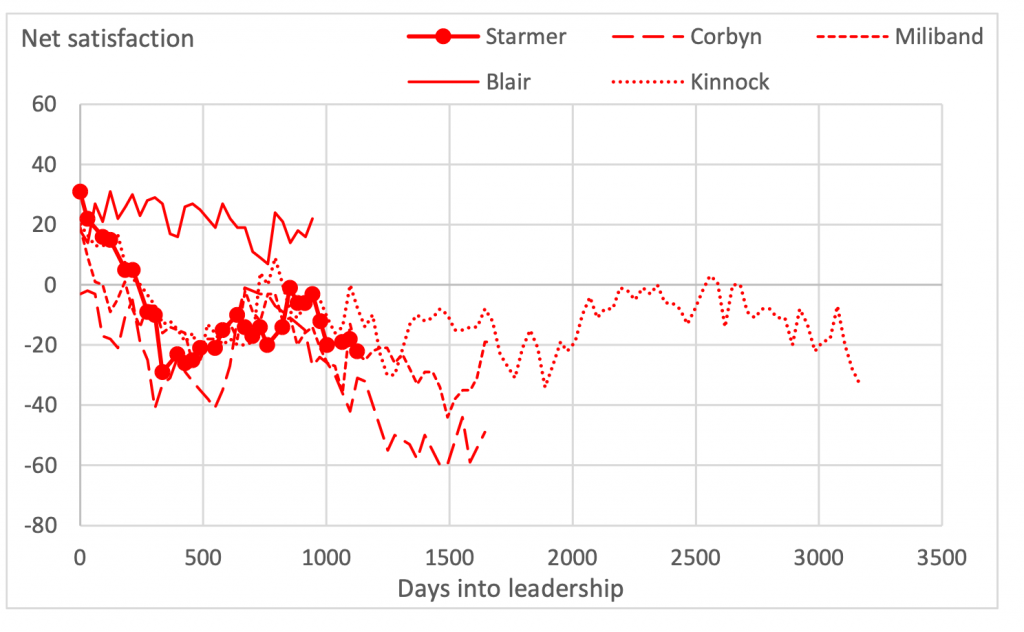Why Labour’s chances of winning a majority are more than 50%

Will Labour win a majority at the next election? One potential barrier that has been much cited here is the party’s poor performance in 2019, which means that it faces a steep climb to win a majority. But others have argued that we should be thinking of its challenge not in terms of the additional seats it needs to gain, but the absolute number of seats it needs to win (326, although de facto fewer).
To formalise the discussion, suppose that the number of seats that Labour wins in a general election, L, depends on a set of variables X. Then the ‘seats gained’ camp implies:
L = L(-1) + Xb + e,
where L(-1) is the seats won at the previous election and e is a random error term reflecting the impact of stuff that’s hard to model.
Whereas the ‘seats won’ camp means:
L = Xb + e.
To figure out which view is correct we can estimate the following relationship:
L = Xb + cL(-1) + e.
If the ‘seats gained’ camp is right then we should find that c=1. Conversely, if the ‘seats won’ camp is right then we will find that c=0.
To estimate this equation, we restrict our interest to England and Wales, as the Scottish situation is idiosyncratic. In terms of our set of variables X, we use relative net leader satisfaction (S) taken from the last Ipsos political monitor prior to the election, plus a constant term. Relative net leader satisfaction is net satisfaction for the Labour leader (satisfied minus dissatisfied) minus net satisfaction for the Conservative leader. We estimate our equation for the 11 general elections since 1979:
L = a + bS + cL(-1) + e,
and obtain the following regression results (standard errors in parentheses below the coefficient estimates):
| a | b | c |
| 176.84 | 2.05 | 0.36 |
| (25.45) | (0.23) | (0.09) |
So neither camp is wholly correct, as the hypotheses that c=0 and c=1 are both comfortably rejected at standard significance levels. The results suggest that, while 2019 is a handicap, each seat that Labour lost then adds only about a third of a seat to the mountain that Labour has to climb for a majority now.
The model does a reasonable job at ‘predicting’ Labour’s E&W seats haul (‘predicting’ because this is a wholly in-sample exercise). The graph below shows the fitted relationship. Apart from the four elections highlighted in the chart, the model is ten seats or fewer off the actual result:

What does this imply for the next election? The obvious problem is that we don’t have our relative net satisfaction variable S and won’t have until the eve of the election. Current (July) polling would give us S=15. If that is where things stand at the next election then Labour should win 281 seats in E&W, and a majority looks out of reach.
However – and this is my key judgement call – I would expect relative leader net satisfaction to be more favourable to Labour by election time. Starmer is a known quantity: he is no Blair, for sure, but he isn’t Corbyn, either. Other Labour leaders who took on the job in opposition, like Kinnock and Miliband, had settled into a pretty flat pattern of modest unpopularity this far into their leadership:

Sunak by contrast has been prime minister for less than a year, and while he is relatively unpopular he is still in his honeymoon period. If he follows the trajectory of other Tory prime ministers who were parachuted into the role mid-parliament – Johnson, May and Major – Sunak could have lost 46 points of net approval by an election next October (chart below).

I don’t think things will play out this badly for the Tories. Sunak has started out so unpopular that it’s pretty much impossible for him to lose 46 additional points of net voter satisfaction. However, I don’t think that the news on the issues voters care about is going to get much better for the Tories, and the more the voters see of Sunak, the less they like him – but replacing him before the next election looks difficult and risky. Meanwhile, I doubt that Starmer will lose much net approval. My best guess, then, is that come election day Starmer will have a net approval of about -20 and Sunak -55.
That would give Labour 322 seats in E&W and, based on a gut-based guestimate of how things play out in Scotland, about 340 seats overall. That is why I think Labour will probably win a majority at the next election – albeit a narrow one. If you want to plug in your own estimates of relative net leader approval, Labour’s baseline with Starmer and Sunak level-pegging in net approval is 250 E&W seats, and you can add about two seats to Labour’s haul for every point by which Starmer’s net approval outstrips Sunak’s. However, DYOR.
Only Living Boy
OLB works in the financial sector and has been a member of the Labour Party since 1992 and this is his debut piece for PB